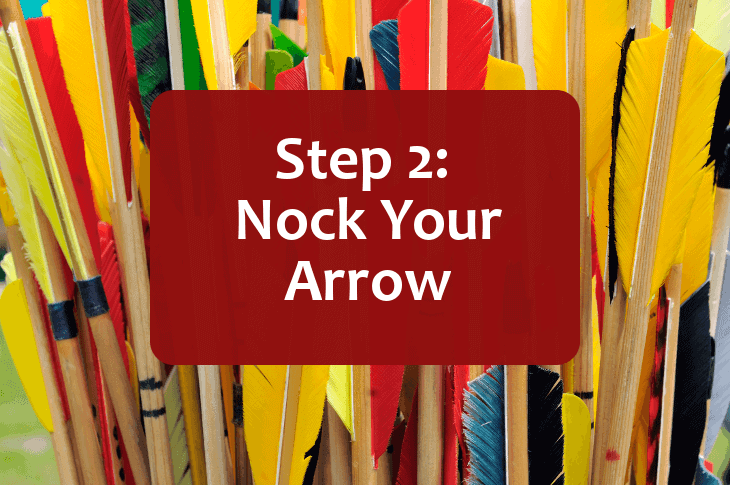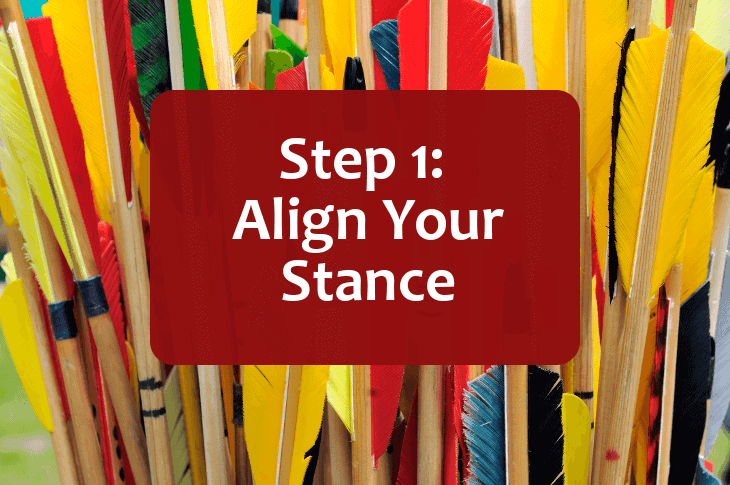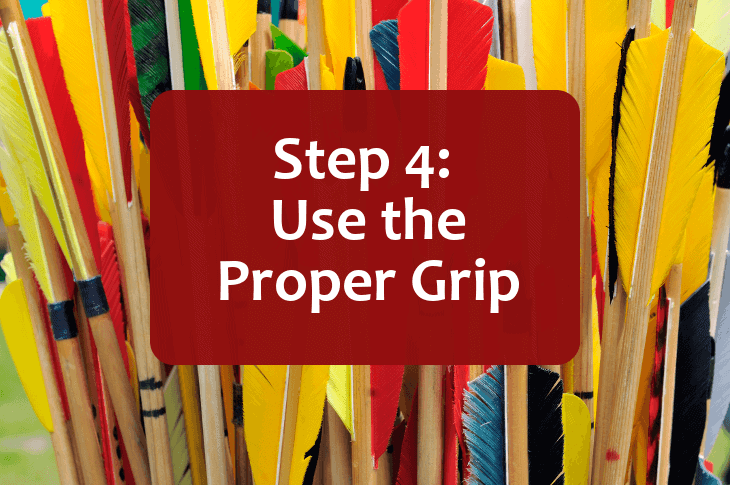Welcome to Step #2! In this post, we’ll talk about how to get the arrow from your quiver and correctly onto your bow string. If you want to jump back to get an overview of the entire shot sequence, you can do so here.
The Nocking Point and the Nock Locator
Before we begin, let’s start with some vocabulary. Different people use the following terms in slightly different ways, but I’ll be using these terms throughout this post.
- When you put an arrow on the string, that’s called “nocking the arrow.”
- A nock locator (sometimes called “string nock”) is a little piece of metal you attach to the bow string, so that you can set…
- A nocking point on your bow.
When you set the nocking point on your bow and attach the nock locator, you’ll be able to attach your arrows to the string at the same place, every time you shoot an arrow. Success in archery means finding what works, and doing it the same way, every single time you shoot an arrow—so when it comes to nocking an arrow, that means nocking the arrow at the same point on the bow string, every single time you shoot an arrow.
If you’re using a rented bow at a range, the range will most likely have set the nocking point on the bow string for you—and that’s a good thing, because setting the nocking point can be challenging! (I’ve detailed the process here if you bought a bow and are ready for some guidance). Your range is most likely to use a finger saver as the nock point, which is a little rubber thingy you can grasp with your fingers, and those are great for beginners.

So You’re Standing There and Your Stance is PERFECT…
…because you practiced your stance in Step #1, and let’s be honest, your kind of a natural at this.
You’re now ready to get an arrow. Reach into your quiver and grab an arrow in the area juuuust in front of the fletching (which are the feather or plastic vanes at the back of an arrow). You’ll see that there are three groupings of feathers on the arrow (or three groupings of plastic, called vanes), and one of them is a unique color. That’s called the index feather (or the index vane, if it’s plastic). We’ll talk about index feathers/vanes in a second.
Make sure the bow is pointing towards the ground (if your bow is pointing up, you may accidently launch an arrow into the air), and make sure your bow limbs are vertical (if your bow is leaning to the left or right, you may interfere with the archer next to you). Set your arrow on your arrow rest. If you’re using a recurve bow, make sure the index feather points away from the bow; if you’re using a compound bow, the index vane may be pointing up, depending on the arrow rest you’re using.
(If you’re wondering about the difference between about which way the index vane is pointing, I explain that in my “How to Choose an Arrow” post—arrows are surprisingly one of the most confusing parts about archery, so check that out that post if you’d like to know more.)
Now that you have the arrow on the arrow rest, click the nock at the end of the arrow into the bow string. There should be a nice, satisfying catch as the nock of the arrow connects to the bow string (and man, I love that feeling!). You may not hear the nock clicking onto the string, but you should be able to feel the nock secure onto the string.
You need to be certain that the arrow is securely attached to the bow string; if it’s not, and the arrow isn’t properly connected, that could result in a dry fire or a wayward arrow, which is bad news.
And, there you go! You’ve nocked an arrow.
Safety Tip #1
This is the most important safety tip—if you’re at the range and you drop an arrow while nocking, LEAVE IT THERE. Most ranges have a very strict rule about dropped arrows: if you’re at the shooting line with a bunch of people and you drop an arrow, or—God forbid—an arrow falls out of your hands and rolls a few feet in front of you—leave it be. Don’t go and pick it up, and even if the arrow has just fallen to your feet ON the line, don’t bend over to pick it up—just leave it there. Holler to a staff member and they’ll come over and pick up the arrow for you. It’s a safety rule that’s enforced to keep you safe, and most ranges are REALLY strict about it, so keep it in mind.
Safety Tip #2
When in doubt, ask somebody with experience. If you’re uncertain about how to nock an arrow, or any other step in the drawing and shooting process, ask a staff person at your range, or someone who’s been practicing archery for a while. If they’re like most archers, they’ll LOVE to help you, and you’ll have to eventually ask them to stop talking about archery so much.
Safety Tip #3
Keep an eye out for your center serving. On your bow string, you’ll see that there’s some extra material right in the middle of the string, right around where the nock/finger saver is located. Over time, this material can fray or tatter, and that may mean it’s time for a new bow string.
Safety Tip #4
Always check the nock at the end of your arrow. I mentioned this is the Commandment about never shooting broken arrows, but I’ll repeat the idea here: the nock is the single point on the arrow that receives all the energy from the bow. Modern arrow manufacturers have come a long way in creating very, very strong nocks, but nocks DO get beat up—especially if you’re reusing your arrows a lot. When you’re nocking the arrow, give the nock a quick look to make sure it’s in good shape. A broken nock may result in a dry fire, and that’s a bad thing. Also check the fletching, the shaft, and the tip, just to be safe.
If Nocking the Arrow Feels a Little Awkward…
That’s totally OK! Most novice archers get a little tangled up while nocking their arrows. If you think about it, you’ve got this big bulky bow, arrows that are always a little longer than they seem, a quiver that’s dangling all over the place—it’s actually pretty hard to coordinate all of that!
But, like absolutely everything else about archery, it gets easier the more you do it. If you look at a person who’s been practicing at the range for a couple months, you’ll see that he/she has a pretty seamless routine of reaching for an arrow and nocking it with zero effort. That’ll be you before too long.
You Wouldn’t Think So, But Nocking the Arrow Can Be an Art
You can always try this, when you get the hang of things. Skip to 1:35 if you’re in a rush…
Wrapping Up Step #2…
This is a surprisingly long post about nocking an arrow! That’s a good thing, though—you want to know all you can.
Next step—Step #3, Grasping the Bow String! Exciting. Click here to read it.




